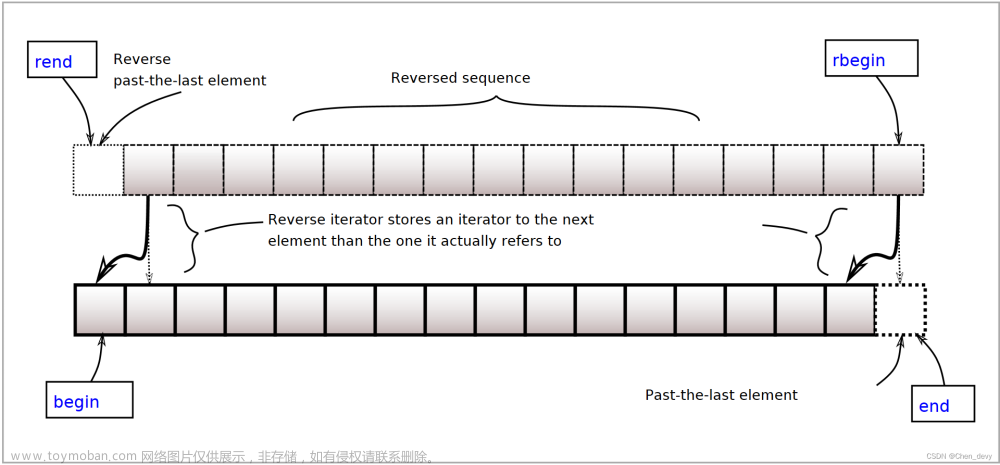✅作者简介:热爱后端语言的大学生,CSDN内容合伙人
✨精品专栏:C++面向对象
🔥系列专栏:C++泛型编程
🔥前言
继
set容器后,今天总结一下map容器的功能,从零到一快速掌握基本使用与常用接口。map在STL编程中与vector、list、set具有同等重要的地位,键值对的方式存储元素在查找时很是高效,那么下面正式开始map容器的学习之旅。
1、map 容器基本操作,从构造到查找统计
1.1、map/ multimap 基本概念
特点:
- map中所有元素都是二元组
pair - 二元组中第一个元素为
key(键),起到索引作用,第二个元素为value(值)- 优点:可以根据key值快速找到value值
- 所有元素都会根据元素的键值自动升序排序
本质:
- map/multimap属于关联式容器,底层结构是用二叉树实现
二者区别:
-
map不允许容器中有重复key值元素 -
multimap允许容器中有重复key值元素
1.2、map 赋值和构造
功能:
- 对map容器进行构造和赋值操作
函数原型:
-
map<T1, T2> mp;默认构造函数: -
map(const map &mp);拷贝构造函数 -
map& operator=(const map &mp);重载等号操作符
代码示例:
// 遍历容器
void printInfo(map<int,int>& mp)
{
for (map<int, int>::iterator it = mp.begin(); it != mp.end(); it++) {
cout << "key = " << it->first << " value = " << it->second << endl;
}
cout << endl;
}
// 构造和赋值
void test01()
{
// 默认构造
map<int, int> mp1;
// 利用二元组显示创建
mp1.insert(make_pair(1,1));
mp1.insert(make_pair(5,2));
mp1.insert(make_pair(4,5));
printInfo(mp1);
// 拷贝构造
map<int, int> mp2(mp1);
printInfo(mp2);
// 赋值
map<int, int> mp3;
mp3 = mp2;
printInfo(mp3);
}
1.3、map 大小和交换
功能:
- 统计map容器大小以及交换map容器
函数原型:
-
size();返回容器中元素的数目 -
empty();判断容器是否为空 -
swap(st);交换两个集合容器
代码示例:
// 大小和交换
void test02()
{
// 大小
map<int, int>mp;
mp.insert(pair<int, int>(1, 10));
mp.insert(pair<int, int>(3, 30));
mp.insert(pair<int, int>(2, 20));
if (mp.empty())
{
cout << "m为空" << endl;
}
else
{
cout << "m的大小为: " << mp.size() << endl;
}
// 交换
map<int, int>m2;
m2.insert(pair<int, int>(4, 100));
m2.insert(pair<int, int>(5, 200));
m2.insert(pair<int, int>(6, 300));
cout << "交换前" << endl;
printInfo(mp);
printInfo(m2);
cout << "交换后" << endl;
mp.swap(m2);
printInfo(mp);
printInfo(m2);
}
1.4、map 插入和删除
功能:
- map容器进行插入数据和删除数据
函数原型:
-
insert(elem);在容器中插入元素。 -
clear();清除所有元素 -
erase(pos);删除pos迭代器所指的元素,返回下一个元素的迭代器。 -
erase(beg, end);删除区间[beg,end)的所有元素 ,返回下一个元素的迭代器。 -
erase(key);删除容器中值为key的元素。
代码示例:
// 插入和删除
void test03()
{
//插入操作
map<int, int> mp;
//第一种插入方式
mp.insert(pair<int, int>(1, 10));
//第二种插入方式,推荐
mp.insert(make_pair(2, 20));
//第三种插入方式
mp.insert(map<int, int>::value_type(3, 30));
//第四种插入方式,不推荐:当不存在此值就会自动创建键,值为0
mp[4] = 40;
// 模拟误操作
cout << "下标为6的值为:"<<mp[6] << endl;
printInfo(mp);
//删除,按迭代器
mp.erase(mp.begin());
printInfo(mp);
// 删除,按下标
mp.erase(3);
mp.erase(6);
printInfo(mp);
//清空
mp.erase(mp.begin(), mp.end());
mp.clear();
printInfo(mp);
}
1.5、map 查找和统计
功能:
- 对map容器进行查找数据以及统计数据
函数原型:
-
find(key);查找key是否存在,若存在,返回该键对应的迭代器;若不存在,返回end(); -
count(key);统计key的元素个数
代码示例:
// 查找和统计
void test04()
{
map<int, int>mp;
mp.insert(pair<int, int>(1, 10));
mp.insert(pair<int, int>(2, 20));
mp.insert(pair<int, int>(4, 40));
mp.insert(pair<int, int>(3, 30));
//查找
map<int, int>::iterator pos = mp.find(3);
if (pos != mp.end())
{
cout << "找到了元素 key = " << (*pos).first << " value = " << (*pos).second << endl;
}
else
{
cout << "未找到元素" << endl;
}
//统计
int num = mp.count(2);
cout << "num = " << num << endl;
}
2、自定义排序规则
与 set 容器一样,定义排序规则需要在创建容器的时候就指定,同样需要借助仿函数,也就是后面会提到的 谓词
2.1、内置数据类型的排序
// 内置数据类型排序
class descmp
{
public:
bool operator()(int val1, int val2) const {
// 指定为降序排列
return val1 > val2;
}
};
void test05()
{
cout << "降序排序插入:" << endl;
map<int, int,descmp> mp;
mp.insert(make_pair(3, 2));
mp.insert(make_pair(7, 4));
mp.insert(make_pair(6, 1));
mp.insert(make_pair(8, 5));
mp.insert(make_pair(1, 3));
for (auto it = mp.begin(); it != mp.end(); it++) {
cout << "key = " << it->first << " value = " << it->second << endl;
}
}

仿函数需要指定为
const常函数类型,否则将会出现数据不完整错误
2.2、自定义数据类型的排序
进行自定义数据类型排序的时候要注意,使用仿函数定义排序规则是针对 键 的,因此要把定义的类、结构体放在泛型的第一个参数上(别问,问就是我看了半天源码才发现的…)
接下来看看我设计的小案例:
// 自定义数据类型排序
class Hero
{
public:
// 构造方法
Hero(string name, int age) :name(name), age(age) {}
// 属性
string name;
int age;
};
class Cmp_hero
{
public:
bool operator()(const Hero& h1, const Hero& h2)const {
return h1.age < h2.age;
}
};
void test06()
{
map<Hero, int, Cmp_hero> mh;
Hero h1("赵云", 42);
Hero h2("曹操", 43);
Hero h3("孙策", 39);
Hero h4("刘备", 40);
Hero h5("关羽", 41);
mh.insert(make_pair(h1, 12000));
mh.insert(make_pair(h2, 14000));
mh.insert(make_pair(h3, 10000));
mh.insert(make_pair(h4, 18000));
mh.insert(make_pair(h5, 16000));
for (auto t = mh.begin(); t != mh.end(); t++) {
cout << "姓名:" << t->first.name << " 年龄:" << t->first.age
<< " 赏金:" << t->second << endl;
}
}

其实更合理的设计应该是按照赏金大小来排序,我之所以这样设计是想介绍一下当键是类的时候该怎么处理:仿函数参数列表中的变量若是 引用形式 必须用
const修饰(若不是引用形式则不用加 const),而且函数也应该是常函数。文章来源:https://www.toymoban.com/news/detail-784158.html
map 容器键值对存储的使用是非常广泛的,下篇博客来做一个员工分组的具体案例,巩固一些 STL常用容器的使用,大家可以订阅专栏,方便查阅和复习。文章来源地址https://www.toymoban.com/news/detail-784158.html
到了这里,关于<C++>map 容器快速上手|自定义数据类型排序的避坑理解的文章就介绍完了。如果您还想了解更多内容,请在右上角搜索TOY模板网以前的文章或继续浏览下面的相关文章,希望大家以后多多支持TOY模板网!










